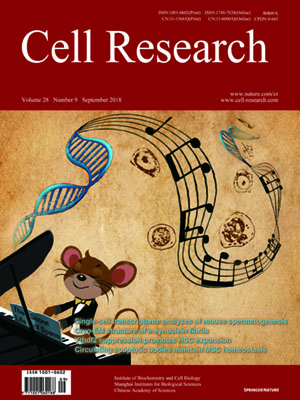
Advanced Search
Submit Manuscript
Advanced Search
Submit Manuscript
Volume 28, No 9, Sep 2018
ISSN: 1001-0602
EISSN: 1748-7838 2018
impact factor 17.848*
(Clarivate Analytics, 2019)
Volume 28 Issue 9, September 2018: 958-961
Si Liu 1, Lingyi Xu 2, Fenghui Guan 2, Yun-Tao Liu 3,4,5, Yanxiang Cui 6,Qing Zhang 7,8, Xiang Zheng 2, Guo-Qiang Bi 3,4,5,9, Z. Hong Zhou 10,11, Xiaokang Zhang 7,8 and Sheng Ye 2,12
1Life Sciences Institute and School of Medicine, Zhejiang University,Hangzhou, Zhejiang 310058, P. R. China; 2Life Sciences Institute and Innovation Center for Cell Signaling Network, Zhejiang University,Hangzhou, Zhejiang 310058, P. R. China; 3Center for Integrative Imaging, Hefei National Laboratory for Physical Sciences at the Microscale, and School of Life Sciences, University of Science and Technology of China (USTC), Hefei, Anhui 230026, P. R. China; 4School of Life Sciences, University of Science and Technology of China, Hefei, Anhui 230026, P. R. China; 5CAS Key Laboratory of Brain Function and Disease, University of Science and Technology of China,Hefei, Anhui 230026, P. R. China; 6Electron Imaging Center for Nanomachines, University of California, Los Angeles, Los Angeles, CA 90095, USA; 7Department of Biophysics, School of Medicine, Zhejiang University, Hangzhou, Zhejiang 310058, P. R. China; 8Center of Cryo Electron Microscopy, Zhejiang University, Hangzhou, Zhejiang 310058, P. R. China; 9CAS Center for Excellence in Brain Science and Intelligence Technology, University of Science and Technology of China, Hefei, Anhui 230026, P. R. China; 10 Department of Microbiology, Immunology, and Molecular Genetics, University of California, Los Angeles, Los Angeles, CA 90095, USA; 11 California NanoSystems Institute, University of California, Los Angeles, Los Angeles, CA 90095, USA and 12 School of Life Sciences, Tianjin University, 92 Weijin Road, Nankai District, Tianjin 300072,P. R. China Correspondence: Correspondence: Z Hong Zhou (hong.zhou@ucla.edu) or Xiaokang Zhang (xzhang1965@zju.edu.cn) or Sheng Ye(sye@zju.edu.cn)These authors contributed equally: Liu S, Xu L and Guan F.
https://doi.org/10.1038/s41422-018-0077-8